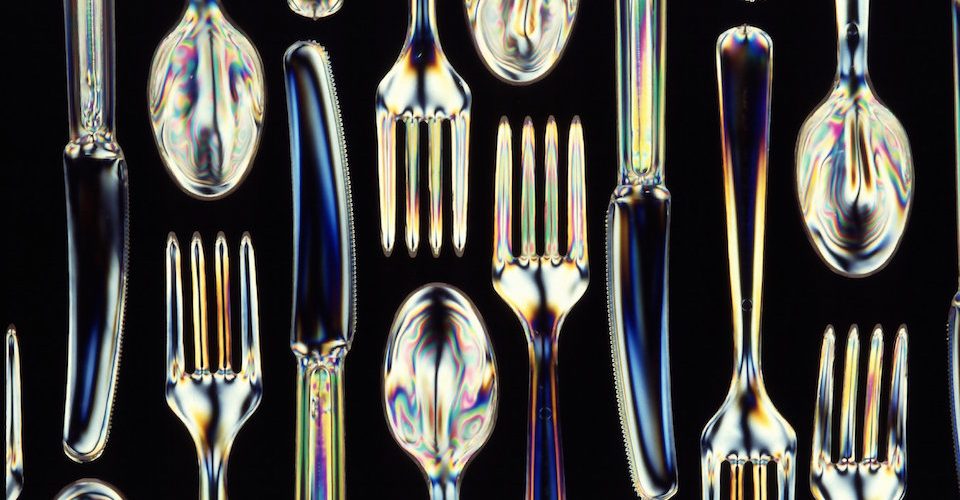Plastic is the scourge of our post-industrial age. So much waste has accumulated that we could – and should – have foreseen.
Plastic is the scourge of our post-industrial age. So much waste has accumulated that we could – and should – have foreseen. As the integral material responsible for shaping our modern lives, petrochemical plastics have fostered our mass consumption and forged our definition of prosperity as something to be be measured by through the accumulation of stuff. Plastic liberated us from the imperfections of human hands, democratized our ability to shop and helped us envision new and easier lives aided by quick and cheap turnaround times and machine-like consistency. Plastic’s design prowess as a material yielded Saarinen tulip chairs, Braun calculators and even a few million McDonald’s Happy Meal toys along the way, but now plastic is wearing out its welcome.
RELATED: Kicking Plastic to the Curb
Can we not just re-engineer our plastic waste and keep melting it down and upcycling it into new stuff? Nope! It’s just not that easy. Those plastic disposable water bottles are the devil incarnate – no matter what you might creatively turn them into later. The energy spent re-engineering petrochemical plastics to break down easier would be better spent pursuing how not to use petroleum as a base material for anything.
RELATED: The Blest Machine turns Plastic into Oil & A Non-Toxic Substitute for Plastic Wrap
Innovative answers to our pathological plastic problem are being sought by returning to nature’s material palette. Bioplastics are readily available on the market and can be seen in little spurts in our daily lives without much fanfare in the form of a fork or a coffee cup here and there. Early bioplastics were designed to mimic their petrochemical predecessors – through colour, mouldability and firmness. Bioplastics all but disappear in reality as a result.
Bioplastics are not so new, by the way. In the 1850s a British chemist created plastics from cellulose, a derivative of wood pulp, and even the great Henry Ford experimented with soy-based plastics for an experimental (but failed) plastic automobile in 1941. Today, bioplastics use many types of renewable biomass materials including vegetable fats and oils, plant starches and even animal and plant excretions.
The way that we experience bioplastics today is often as polylactide acid (PLA). PLA looks and behaves just like petrochemical plastic, so we perceive it as plastic. We find PLA in food containers, disposable cutlery, decking material, outdoor furniture, children’s toys and even architectural mouldings. According to explainthatstuff.com, PLA can save up to two-thirds the energy needed to make traditional plastics, but unlike traditional plastics and biodegradable plastics, PLA does not produce a net increase in carbon dioxide gas when it breaks down. Some PLA has been engineered to break apart into small fragments so that bacteria can digest it more easily and speed up the biodegradation process.
But it’s not tough enough. Don’t get me wrong – PLA is good, but bioplastics have yet to fully meet the performance requirements needed to lend themselves to more durable goods. Picking up where Henry Ford left off, BC’s Solegear has produced a product called Polysole that represents a big step forward in the development of bio-based high-performance compostable plastics. Solegear began its investigations into bioplastics by focusing on re-designing the basic material building blocks needed in conventional injection moulding processes. The company then pushed for greater performance goals by focusing on strength, durability, processing and compostability.
Solegear’s research has resulted in new technologies and new materials capable of use in thermoforming and blowmoulding. Its work has included sharing data with leading Canadian research institutions like the NRC Industrial Materials Institute in Boucherville, QC; the École Polytechnique in Montréal; and the University of British Columbia in Vancouver to encourage new uses and product development using their new material.
However, I wonder about how much further we need to take bioplastics to truly free us from the constraints of past manufacturing methods that we associate with plastic. What if our plasticized world were reconceived and remade on the foundation that all plastic matter will now be biomatter – or better yet – a source of food for us, our animals or the earth? Who or what might eat my discarded computer?
Maybe when we stop trying to make bioplastics behave like a surrogate for petrochemical plastics we might stumble upon new roles and forms for bioplastics to take on in our daily lives.
Dutch designer Lieske Schreuder noticed that the snails in her garden seemed to enjoy eating paper and cardboard, so she purchased hundreds of snails and built a laboratory to test what would happen if they consumed coloured cellulose paper. Now, with a unique form of biomanufacturing, she makes floor tiles from their brightly-coloured excrement.
As Guardian blogger Oliver Wainwright pointed out last year, students at Imperial College and the Royal College of Art were using chitin from crabs – the long-chain polymer of a N-acetylglucosamine and a derivative of glucose that is found in the cell walls of crab exoskeletons – mixed with red algae and glycerine to make biorubber.
Johanna Schmeer’s fringy experimental project “Bioplastic Fantastic” features seven different devices made from “enzyme-enhanced bioplastics” that provide all the nutrients humans would ever need to live: protein, fat, water, fiber, sugar, vitamins and minerals.
Bioplastics may just need to be subjected to such design extremes in order to help us reconceive our relationship with plastic as a material altogether. Maybe when we stop trying to make bioplastics behave like a surrogate for petrochemical plastics we might stumble upon new roles and forms for bioplastics to take on in our daily lives – not just some dorky forks made from corn starch.
Just imagine if Henry Ford had stuck to his guns in 1941. Where would we be now? I suggest that we would be in a much better place with much less plastic waste. Canadian companies like Solegear and designers like Lieske Schreuder are leading us down a very useful and unfamiliar path.
Eric Nay is an architect, designer, artist and a professor at OCAD University. His blog, Made in Canada, profiles examples of Canadian design innovation, including sustainable buildings and design, craft practices and innovative businesses across the country.













